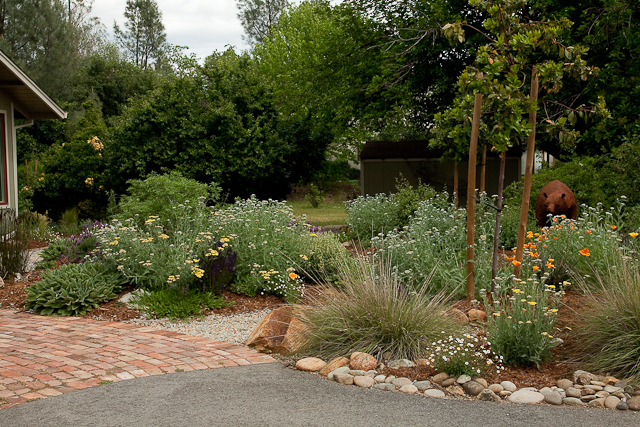| |
Leslie's garden
A drought tolerant garden with Californian natives and other mediterranean plants in Redding along the Sacramento river.

SLIDE SHOW WITH ALL PHOTOS
Background story
We have been on our 2 ½ acre property on the Sacramento River for 6 years. The natural beauty and “sense of place” surrounding us has inspired the garden design with several goals in mind. The diverse plant palette was chosen for drought-tolerance, durability, and wildlife habitat benefits. (Resident deer prone to munching influenced plant choice possibilities as well!) The combination of California native and Mediterranean plants more adapted to our climate and soil provide continuing seasonal interest. Sustainable landscape practices such as composting, mulching, water conservation, the creation/conservation of wildlife habitat, and appropriate plant choices that require little pruning reduce off-site waste. There are no pesticides or herbicides used in the garden. Instead, plants are chosen to attract beneficial insects to control problems.
As the house was built in the 50’s, we were fortunate to have some mature tree and shrub specimens on site, such as the southern magnolia, fruitless and fruiting mulberry, camellias, forsythia and others. Even more exciting were the native trees that were here, including gray pine, cottonwoods, oaks, and willows. These elements provided a framework into which the new garden was designed. The garden mounds were created with imported native soil from a nearby pool excavation. These provide an interesting change in topography, as well as the drainage required for both native and Mediterranean plants. There is no automatic watering system on the property. Deep, infrequent watering is the goal as the garden becomes more established.
The use of recycled materials is demonstrated in the front walk from bricks salvaged from the house before the remodel and back yard “urbanite” stepping stones cut from the old concrete patio. Gravel pathways and living areas provide a permeable surface for water absorption. The street side split-rail fence is actually made of colored concrete, a product called “Timbercrete.” The curved seating wall celebrates the course of the Sacramento as you glance upriver, and is a cozy gathering spot around a portable fire pit in the cooler months. Rock cobble throughout was obtained on site. Rolled willow fencing provides a natural backdrop to native woodland plantings, and disguises an existing chain link fence.
Garden art includes birdbaths and birdhouses to invite wildlife. The arbor depicting geese in flight supports the California wild grape variety ‘Roger’s Red ’and is a very sentimental piece. It was created by my late father, Ken Kirk, for my daughter’s outdoor wedding, as were the topiaries displayed on site. Doug Stewart was the artist who created the oxidized metal bear sculpture in the front yard. A trellis made from recycled metal screens the garden shed and is planted with pipevine, host plant for the Pipevine Swallowtail caterpillar.
As a garden designer, it is a joy to use nature as a model and mentor for healthy landscapes. By creating beneficial relationships between plants and wildlife we enrich our environments and our own lives.
Leslie Irey (www.leslieireygardendesign.com)
|
|